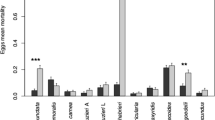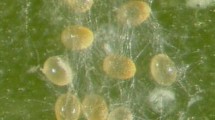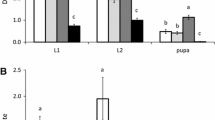Abstract
The objective of this study was to evaluate the oviposition rate and the survivorship of some of the most common predators on plants of the natural vegetation of southeastern Brazil, when confined with different food sources. Forty-four laboratory tests were carried out, each corresponding to a different combination of predator species and food source. The predators tested were: Phytoseiidae—Amblyseius acalyphus, Euseius citrifolius, Iphiseiodes zuluagai, Metaseiulus (Metaseiulus) camelliae, Typhlodromips cananeiensis; Stigmaeidae—Agistemus floridanus, Zetzellia malvinae; Tydeidae—Pronematus sp. For most predators, the highest oviposition rate and survivorship were obtained when the prey was one of the tenuipalpid mites, Brevipalpus phoenicis or Tenuipalpus heveae. With the exception of A. floridanus, the predators had low oviposition rate and survivorship on Calacarus heveae relative to their respective rate on other food sources. Predators had also generally low oviposition rate and survivorship when feeding on Tetranychus urticae, Oligonychus gossypii or Frankliniella sp.
Similar content being viewed by others
References
Abou-Awad BA, El-Sawaf BM, Reda AS, Abdel-khalek AA (2000) Environmental management and biological aspects of the two eriophyoid fig mites Aceria ficus (Cotte) and Rhyncaphytoptus ficifoliae Keifer in Egypt. J Pest Sci 73(1):5–12
Bellini MR, de Moraes GJ, Feres RJF (2005) Mites (Acari) of two cultivation systems adopted in northwestern State São Paulo. Neotrop Entomol 34(3):475–484
Chagas CM, Kitajima EW, Rodrigues JCV (2003) Coffee ringspot virus vectored by Brevipalpus phoenicis (Acari: Tenuipalpidae) in coffee. Exp Appl Acarol 30(1):203–213
De Vis RMJ, de Moraes GJ, Bellini MR (2006) Mites (Acari) of rubber trees (Hevea brasiliensis Muell Arg, Euphorbiaceae) in Piracicaba, State of São Paulo, Brazil. Neotrop Entomol 35(1):112–120
English-Loeb G, Norton AP, Gadoury DM, Seem RC, Wilcox WF (1999) Control of powdery mildew in wild and cultivated grapes by a Tydeid mite. Biol Control 14:97–103
Feres RJF (2000) Levantamento e observações naturalísticas da acarofauna (Acari, Arachnida) de seringueiras cultivadas (Hevea spp, Euphorbiaceae) no Brasil. Rev Bras Zool 17(1):157–173
Feres RJF (2001) Primeiro registro de ácaros eriofídeos (Acari, Eriophyidae) em seringueiras (Hevea brasiliensis Muell Arg, Euphorbiaceae) da floresta amazônica. Rev Bras Zool 18:343–345
Feres RJF, de Moraes GJ (1998) Phytoseiid mites (Acari: Phytoseiidae) from woody areas in the State of São Paulo, Brazil. Syst Appl Acarol 3:125–132
Feres RJF, Rossa Feres C de C, Daud RD, Santos RS (2002) Diversidade de ácaros (Acari, Arachnida) em seringueiras (Hevea brasiliensis Muell Arg, Euphorbiaceae) na região noroeste do Estado de São Paulo, Brasil. Rev Bras Zool 19:137–144
Ferla NJ, de Moraes GJ (1998) Ácaros predadores em pomares de maçã no Rio Grande do Sul. Anais da Sociedade Entomol Bras 27:649–654
Ferla NJ, de Moraes GJ (2002) Ácaros (Arachnida, Acari) da seringueira (Hevea brasiliensis Muell Arg) no Estado do Mato Grosso, Brasil. Rev Bras Zool 19:867–888
Ferla NJ, de Moraes GJ (2003a) Biologia de Agistemus floridanus Gonzalez (Acari, Stigmaeidae). Rev Bras Zool 20:261–264
Ferla NJ, de Moraes GJ (2003b) Oviposição dos ácaros predadores Agistemus floridanus Gonzalez, Euseius concordis (Chant) e Neoseiulus anonymus (Chant & Baker) (Acari) em resposta a diferentes tipos de alimento. Rev Bras Zool 20:153–155
Flechtmann CHW (1989) Seringueira (Hevea sp), um novo hospedeiro para Oligonychus gossypii (Zacher, 1920) (Acari: Tetranychidae). Boletim do museu Paraense Emilio Goeldi 5(1):128–128
Gerson U, Smiley RL, Ochoa R (2003) Mites (Acari) in biological control. Blackwell Science, Boston, 539 pp
Gondim MGC Jr, de Moraes GJ (2001) Phytoseiid mites (Acari: Phytoseiidae) associated with palm trees (Arecaceae) in Brazil. Syst Appl Acarol 6:65–94
Knop NF, Hoy MA (1983) Factors limiting the utility of Homeopronematus anconai (Acari: Tydeidae) in integrated pest management in San Joaquin Valley vineyards. J Econ Entomol 76:1181–1186
Laing JE, Knop NF (1983) Potential use of predaceous mites other than Phytoseiidae for biological control of orchard pests. In: Hoy MA et al (eds) Biological control of pests by mites. University of California, Berkeley, pp 28–35
McMurtry JA, Croft BA (1997) Life-styles of phytoseiid mites and their role in biological control. Annu Rev Entomol 42:129–321
Monteiro LB (1994) Manejo integrado de Panonychus ulmi em macieira. Primeiras experiências com a introdução de Neoseiulus californicus. Rev Bras Fruticultura 16(1):46–53
Monteiro LB (2002) Criacão de ácaros fitófagos e predadores: um caso de produção de Neoseiulus californicus por produtores de maçã. In: Parra JRP et al (eds) Controle Biológico no Brasil: Parasitóides e Predadores. Manole, São Paulo, pp 351–366
Moraes GJ (2002) Controle biológico de ácaros fitófagos com ácaros predadores. In: Parra JRP et al (eds) Controle Biológico no Brasil: Parasitóides e Predadores. Manole, São Paulo, pp 225–238
Moraes GJ, McMurtry JA (1981) Biology of Amblyseius citrifolius (Denmark and Muma) (Acarina – Phytoseidae). Hilgardia 49:1–29
de Moraes GJ, McMurtry JA, Denmark HA, Campos CB (2004) A revised catalog of the mite family Phytoseiidae. Zootaxa 434:1–494
Rodrigues JCV, Kitajima EW, Childers CC, Chagas CM (2003) Citrus leprosis virus vectored by Brevipalpus phoenicis (Acari: Tenuipalpidae) on citrus in Brazil. Exp Appl Acarol 30(1):161–179
Sabelis MW, Bakker FM (1992) How predatory mites cope with the web of their tetranychid prey: a functional view on dorsal chaetotaxy in the Phytoseiidae. Exp Appl Acarol 16:2003–2225
Sato ME, Raga A, Cerávolo LC, Rossi AC, Potenza MR (1994) Ácaros predadores em pomar cítrico de Presidente Prudente, Estado de São Paulo. Anais da Sociedade Entomol Bras 23(3):435–441
Van Houten YM, Van Rijn PCJ, Tanigoshi LK, Van Stratum P, Bruin J (1995) Pre-selection of predatory mites to improve year-round biological control of western flower thrips in greenhouse crops. Entomol Exp Appl 74:225–234
Walter DE, O’Dowd DJ (1992a) Leaves with domatia have more mites. Ecology 73:1514–1518
Walter DE, O’Dowd DJ (1992b) Leaf morphology and predators: effect of leaf domatia on the abundance of predatory mites (Acari: Phytoseiidae). Environ Entomol 21:478–484
White ND, Laing JE (1977) Some aspects of the biology and a laboratory life table of the acarine predator Zetzellia mali. Can Entomol 109:1275–1281
Zacarias MS, de Moraes GJ (2001) Phytoseiid mites (Acari) associated with rubber trees and other euphorbiaceous plants in southeastern Brazil. Neotrop Entomol 30(4):579–586
Zhang ZQ (2003) Mites of greenhouses: identification, biology and control. CABI Publishing, Wallingford, 244 pp
Acknowledgements
To FAPESP (State of São Paulo Research Foundation), for the post-doctoral fellowship awarded to the first author. This work was supported by FAPESP within the BIOTA/FAPESP—The Biodiversity Virtual Institute Program (http://www.biotasp.org.br). To Antonio C. Lofego for supplying a colony of A. acalyphus for use in the study. To Edmilson S. Silva, Antonio C. Lofego and Aníbal R. Oliveira for their help during this study. To Marcos S. Bernardes, Departamento de Produção Vegetal, ESALQ/USP, for logistical support. To “Plantações E. Michelin Ltda.” and “Guaporé Pecuária S/A” for the financial support.
Author information
Authors and Affiliations
Corresponding author
Rights and permissions
About this article
Cite this article
De Vis, R., de Moraes, G. & Bellini, M. Initial Screening of Little Known Predatory Mites in Brazil as Potential Pest Control Agents. Exp Appl Acarol 39, 115–125 (2006). https://doi.org/10.1007/s10493-006-9004-7
Received:
Accepted:
Published:
Issue Date:
DOI: https://doi.org/10.1007/s10493-006-9004-7




